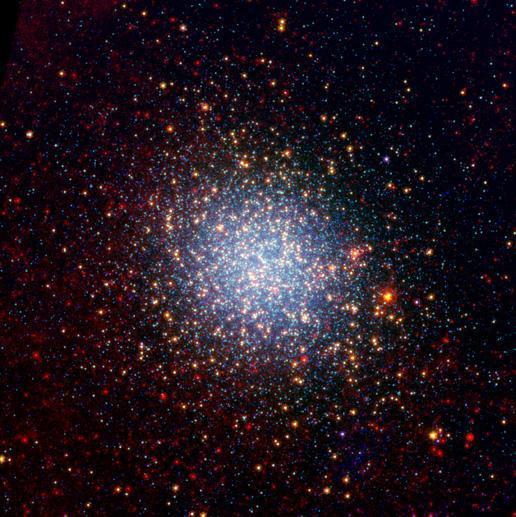
An infrared image of the globular cluster Omega Centaurus, taken by the Spitzer Space Telescope.
Dust is scattered throughout space, and is composed of fine particles of silicates like sand on earth, or of carbon (often blended with other elements). The dust strongly absorbs light at ultraviolet and visible wavelengths, and in our galaxy large clouds of dust are sometimes seen as dark shapes in front of bright nebula as the dust dims our view of the light behind it (the famous Horsehead Nebula, for example). Knowing the composition and other properties of the dust helps astronomers correct for the effects of this extinction to obtain accurate properties of background stars that are partially obscured, properties like their intrinsic brightnesses. Knowing the dust composition also refines our tally of the relative amounts of the different elements in our galaxy. Dust plays a crucial role in the formation of new stars, and of course in producing circumstellar disks of material from which planets ultimately form.
Where does dust come from? Astronomers know that most of the atomic elements in dust are produced in stars. After completing their dominant phase of hydrogen burning, modest-sized stars will blow off material in the form of dust (and gas), while more massive stars produce and expel dust when they explode as supernovae. The details, however, remain very uncertain. For example, no one knows exactly how much dust is ejected in these processes, or the proportion of silicate versus graphite, or the distribution of grain sizes, or the dust shapes.
SAO astronomer Andrea Dupree has teamed up with seven colleagues to study the dust production in giant stars in the globular cluster Omega Centauri (Omega Cen). A globular cluster is a roughly spherical ensemble of stars (as many as several million) that are gravitationally bound together in groups whose diameters can be as small as only tens of light-years. Omega Cen is the biggest and brightest globular cluster in our galaxy, with about 5 million solar masses, and is located about 15,000 light-years away from us. Globular clusters like this one are especially valuable place in which to study dust production because all the stars in the cluster are coeval and at the same distance, and so any possible evolutionary effects can be measured relatively accurately.
In a new paper appearing in the Monthly Notices of the Royal Astronomical Society, the scientists report using the Spitzer Space Telescope to study 6875 stars in Omega Cen, and fitting their measurements to stellar models. The find that the cluster is producing dust at a rate of about .0003 earth-masses per year, with about half of that coming from only two exceptional stars in the cluster; the temperature of the dust in the cluster is about 550 kelvin. The work is important for determining this and numerous other details about dust production and composition. In addition, the team was able to refine the distance to the cluster to a precision of about 7%, about a factor of two improvement.